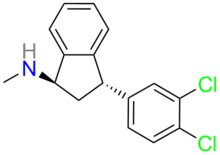Indatraline
 |
|
| Clinical data | |
|---|---|
| Routes of administration |
Oral |
| ATC code |
|
| Legal status | |
| Legal status |
|
| Identifiers | |
|
|
| CAS Number | |
| PubChem CID | |
| ChemSpider | |
| UNII | |
| ChEMBL | |
| Chemical and physical data | |
| Formula | C16H15Cl2N |
| Molar mass | 292.2072 g/mol |
| 3D model (Jmol) | |
|
|
|
|
Indatraline (Lu 19-005) is a non-selective monoamine transporter inhibitor that has been shown to block the reuptake of dopamine, norepinephrine, and serotonin with effects similar to those of cocaine. However, the effects have been shown to have slower onset and longer duration than cocaine, suggesting that the compound may, along with similar compounds, be used for treatment of cocaine addiction. Apparently, Lu 19-005 can be used to block the action of methamphetamine and MDMA.
Compare Indatraline with tametraline since they are directly homologous. There are some differences though. Superposition should make it possible to see that there is at least a relationship between the pharmacophore of indatraline and various phenyltropanes. More recently, additional work has been done also.
If indatraline is N-alkylated it is possible to slow the onset of action, if the choice of alkyl group is sufficiently bulky, so that it is not until N-demethylation occurs that the molecules become really active. N-methyl indatraline has a much longer duration than indatraline, because norindatraline is inactive whereas demethylating N-methyl-indatraline does not terminate the actions of the parent compound. Most drug addiction programs are of the opinion that a "slow onset, long duration" DRI is less likely to be abused (c.f. Volkow and others). The N-methyl products are clearly not just inactive prodrugs though.
Measurement of ambulation was recorded in 10-minute bins. Whereas for cocaine, locomotor activity (LMA) was already apparent at 10 min, at least 20 minutes were needed before the NMe2 analogs even started to increase locomotor activity. Very high doses actually meant less ambulation. The reason for this was increased stereotypy. It is apparent from the table that larger N-groups result in increased DAT selectivity relative to the SERT and NET. Although it is not necessary to enter into the details, the authors actually wanted a SNDRI.
...
Wikipedia
